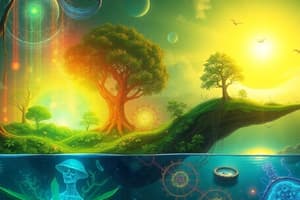Podcast
Questions and Answers
Which of the following is NOT a function of the chemical energy produced by photosynthesis?
Which of the following is NOT a function of the chemical energy produced by photosynthesis?
- Growth
- Reproduction
- Absorption of light energy (correct)
- Movement
What is the main purpose of photosynthesis for organisms?
What is the main purpose of photosynthesis for organisms?
- To produce oxygen for the atmosphere
- To break down sugar molecules for energy
- To absorb carbon dioxide from the atmosphere
- To convert light energy into chemical energy (correct)
Which of the following organisms are considered producers?
Which of the following organisms are considered producers?
- Fungi
- Animals
- Plants (correct)
- Bacteria
What is the role of chlorophyll in photosynthesis?
What is the role of chlorophyll in photosynthesis?
Where in a plant cell does photosynthesis take place?
Where in a plant cell does photosynthesis take place?
What is the chemical energy produced by photosynthesis primarily stored in?
What is the chemical energy produced by photosynthesis primarily stored in?
Which of the following is NOT a reactant in the photosynthesis process?
Which of the following is NOT a reactant in the photosynthesis process?
What is the overall percentage of radiant energy from the sun that is reflected back into space?
What is the overall percentage of radiant energy from the sun that is reflected back into space?
Flashcards
Photosynthesis
Photosynthesis
The process by which producers convert sunlight into chemical energy stored in sugars.
Chlorophyll
Chlorophyll
Green pigment found in chloroplasts that captures light energy during photosynthesis.
Cellular Respiration
Cellular Respiration
The process by which organisms release energy stored in glucose.
Producers
Producers
Signup and view all the flashcards
Consumers
Consumers
Signup and view all the flashcards
Radiant Energy
Radiant Energy
Signup and view all the flashcards
Chemical Energy
Chemical Energy
Signup and view all the flashcards
Energy Flow
Energy Flow
Signup and view all the flashcards
Study Notes
Photosynthesis and Cellular Respiration
-
Photosynthesis is the process where producers (green plants) create glucose (chemical energy) from light energy. They do not need to consume other organisms for energy.
-
Cellular respiration is a process occurring in producers and consumers that provides energy to cells. Chemical bonds in glucose are broken releasing chemical energy that organisms use for growth, repair and reproduction.
Energy Flow
- All organisms require energy to survive.
- Most energy for organisms comes from the sun (radiant energy).
- Light is a visible form of radiant energy.
Solar Radiation
- Roughly 70% of radiant energy is absorbed by the hydrosphere and lithosphere converting it to thermal energy.
- Thermal energy warms the atmosphere, evaporates water and creates winds.
- About 30% of radiant energy is reflected back into space.
- A small fraction (0.023%) of radiant energy is absorbed directly by living organisms through photosynthesis, converting it into chemical energy.
Chemical Energy
- Chemical energy is stored in cells and released as needed.
- All organisms utilize chemical energy for functions like movement, growth, and reproduction.
Producers and Consumers
- Producers create their own food via photosynthesis taking in light energy to create sugars.
- Consumers need to eat/consume other organisms to get energy, because they cannot perform photosynthesis
Photosynthesis
-
Virtually all chemical energy contained in food originated from light energy captured during photosynthesis.
-
In photosynthesis, producers convert the sun's light energy into chemical energy stored in sugar (glucose) molecules.
-
Plants use or store glucose (sugars).
-
Producers absorb carbon dioxide from the air and water, using the Sun's energy to convert it to sugars and oxygen.
-
Chemical Equation: 6CO2 + 6H2O + sunlight → C6H12O6 + 6O2
Location of Photosynthesis
- Photosynthesis occurs within chloroplasts in plant cells.
- Chloroplasts contain chlorophyll, a green pigment that captures light energy for photosynthesis.
Cellular Respiration
- Photosynthesis produces stored energy in the form of sugar.
- Cellular respiration is a complementary process to make the stored energy from sugar usable for the organism.
- Chemical Equation: C6H12O6 + 6O2 → 6CO2 + 6H2O + ATP
Cellular Respiration Location
- Cellular respiration takes place in the mitochondria, often called the powerhouse of the cell.
Complementary Processes
- Photosynthesis and Respiration are complementary processes.
- The products of one reaction are reactants in the other.
- Products of cellular respiration (CO2 and water) are the inputs for photosynthesis.
- Respiration produces CO2 and water needed by photosynthesis, which produces the sugars and oxygen needed by respiration .
Studying That Suits You
Use AI to generate personalized quizzes and flashcards to suit your learning preferences.




